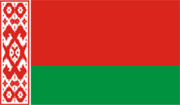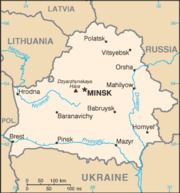Belarus
| Full country name | Republic of Belarus |
| Capital | Minsk |
|
Area |
207,595 km2 |
|
Administrative divisions |
6 regions called oblasts. They are divided into 118 raions. |
|
Population |
9,349,645 (2021 census) |
| Ethnic groups | 84.9% Belarusians 7.5% Russians 3.1% Poles 1.7% Ukrainians 2.8% Other |
|
Religion |
55.4% Christianity —48.3% Eastern Orthodoxy —7.1% Other Christian 41.1% No religion 2.4% Other 1.1% Unspecified |
|
Language |
Belarusian and Russian |
|
Currency |
Belarusian ruble (BYN) |
|
Government type |
Unitary presidential republic under a dictatorship |
|
President |
Alexander Lukashenko (disputed) |
|
Human Development Index |
0.823 | 53rd |
| View Full Source | Wikipedia |
Belarus, country of eastern Europe. Until it became independent in 1991, Belarus, formerly known as Belorussia or White Russia, was the smallest of the three Slavic republics included in the Soviet Union (the larger two being Russia and Ukraine).
While Belarusians share a distinct ethnic identity and language, they never previously enjoyed unity and political sovereignty, except during a brief period in 1918. Belarusian history is thus less an isolable national narrative than a study of regional forces, their interplay, and their effects on the Belarusian people. The territory that is now Belarus underwent partition and changed hands repeatedly; as a result, much of the history of Belarus is inseparable from that of its neighbours. Since independence Belarus has retained close ties to its most dominant neighbour, Russia. In 1999 the two countries signed the Union State Foundation Treaty, which aimed to create a politically integrated confederation with a common currency; the precise nature of the partnership, however, remained unclear well into the 21st century. The legacy of Belarus’s Soviet past also continued to manifest itself, both in the persistent prominence of communist political parties and in the country’s authoritarian style of government. About one-fifth of the population of Belarus resides in the centrally located capital, Minsk, a sprawling modern city that was almost entirely rebuilt after its near destruction in World War II.
Source : Britannica
 Flag of Belarus
Flag of Belarus Map of Belarus
Map of Belarus
